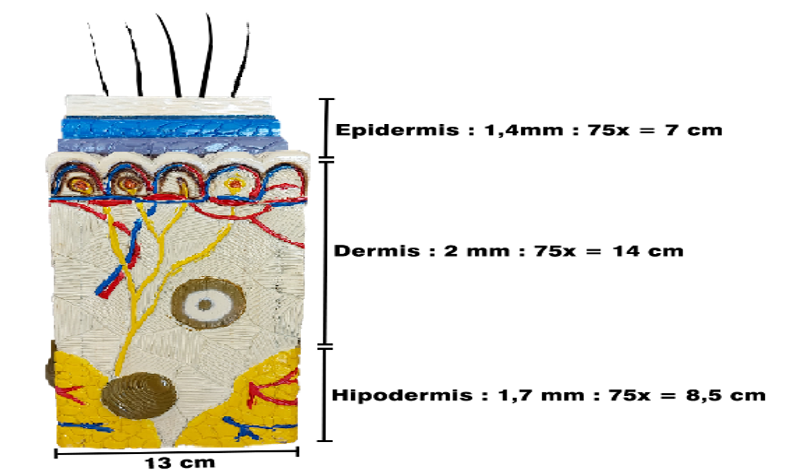Learning media development of the cheap skin-based model for medical faculty students at Tadulako University
DOI:
https://doi.org/10.22219/raden.v2i1.19875Keywords:
Learning, Skin, Validation, Mannequin Model, Medical studentAbstract
A model is a learning media that is used instead of the real human body to increase students' knowledge and can also practice medical skills, which are impossible to apply to real patients. Learning using models is the first order in learning clinical skills before students proceed to the next stage, namely practicing with friends and the last one is going directly to the community. The purpose of this study was to design, create and analyze a skin model made from cheap raw materials like wood so that it can be used as a learning aid at the Faculty of Medicine, Tadulako University. This research applied a qualitative approach with the Research and Development method. The sampling technique as the informant was taken through purposive sampling. The informants consisted of a dermatologist and sex expert, a medical education expert, and a histology lecturer. Data was collected through in-depth interviews and observation. Data analysis was carried out by analyzing the opinions of the informants using questionnaires to help guide the interview. The cheap leather model shows a fairly realistic mannequin shape with colors that can distinguish each layer and can be used as a learning aid for students in the histology department. Learning media development of the cheap leather model shows a fairly realistic mannequin shape with colors that can distinguish each layer and can be used as a learning aid for students in the histology department.
Downloads
References
Delani, A. F., Antartika, I. K., & Mardani, D. M. S. (2017). Pengembangan media kartu asosiasi gambar" katakana-ina" untuk pembelajaran katakana bagi pemula di SMA Negeri 4 Singaraja. Jurnal Pendidikan Bahasa Jepang Undiksha, 3(3), 504–514.
Demak, I., Tanra, A., Sari, P., Sumarni, S., & Mutiarasari, D. (2019). Manekin kateterisasi berbahan baku murah sebagai alat bantu belajar pre klinik (1st ed.). Untad Press.
Fathunikmah, F., & Rafida, R. (2018). Uji Coba Model “My” Terhadap Keterampilan Klinis Penjahitan Perineum Derajat Dua. SEAJOM: The Southeast Asia Journal of Midwifery, 4(1), 14–21.
Handayani, S. (2021). Anatomi dan Fisiologi Tubuh Manusia. Media Sains Indonesia.
Krisdianto, K., Satiti, E. R., & Supriadi, A. (2018). Perubahan warna dan lapisan finishing lima jenis kayu akibat pencuacaan. Jurnal Penelitian Hasil Hutan, 36(3), 205–218.
Lusi, A. L. (2017). Media pembelajaran anatomi fisiologi kulit menggunakan teknologi Augmented Reality berbasis android. Institut Teknologi Telkom Purwokerto.
Maryuningsih, Y., Hidayat, T., Riandi, R., & Rustaman, N. (2019). Developing Gen-21cs on smartphone to cultivate the 21st-century skills on biology teacher candidates. JPBI (Jurnal Pendidikan Biologi Indonesia), 5(3), 415–424. https://doi.org/10.22219/jpbi.v5i3.9714
Miranto, A. N., & Wardani, K. K. (2019). Perancangan Aplikasi Anatomi dan Fisiologi pada Sistem Kardiovaskular sebagai Pendukung Pembelajaran Mahasiswa Kedokteran Umum. Jurnal Sains Dan Seni ITS, 8(1), 7–12.
Moniz, T., Costa Lima, S. A., & Reis, S. (2020). Human skin models: From healthy to disease‐mimetic systems; characteristics and applications. British Journal of Pharmacology, 177(19), 4314–4329.
Murlistyarini, S., Prawitasari, S., & Setyowatie, L. (2018). Intisari Ilmu Kesehatan Kulit dan Kelamin. Universitas Brawijaya Press.
Riyana, C. (2015). Peranan Teknologi dalam Pembelajaran. Pengembangan ICT Dalam Pembelajaran. https://doi.org/10.1016/j.revmed.2010.08.003
Rizalanda, S., Soebadi, D. M., & Sustini, F. (2019). Peningkatan Pengetahuan Dan Keterampilan Konseling Vasektomi Menggunakan Manekin, Video, Leaflet, Dan Poster. Jurnal Keperawatan Muhammadiyah, 4(2).
Santoso, D. (2017). Begini Mencetak Dokter Profesional. Airlangga University Press.
Sumiharsono, M. R., & Hasanah, H. (2018). Media Pembelajaran. Pustaka Abadi.
Sumiharsono, R., & Hasanah, H. (2017). Media pembelajaran: buku bacaan wajib dosen, guru dan calon pendidik. Pustaka Abadi.
Sumiyati, S., Anggraini, D. D., Kartika, L., Arkianti, M. M. Y., Sudra, R. I., Hutapea, A. D., Sari, M. H. N., Rumerung, C. L., Sihombing, R. M., & Umara, A. F. (2021). Anatomi Fisiologi. Yayasan Kita Menulis.
Yusuf, M. M., Amin, M., & Nugrahaningsih, N. (2017). Developing of instructional media-based animation video on enzyme and metabolism material in senior high school. JPBI (Jurnal Pendidikan Biologi Indonesia), 3(3), 254–257.

Downloads
Published
How to Cite
Issue
Section
License
Copyright (c) 2022 Muhlasin et al

This work is licensed under a Creative Commons Attribution-ShareAlike 4.0 International License.
Authors who publish with Research and Development in Education agree to the following terms:
- For all articles published in the Research and Development in Education, copyright is retained by the authors. Authors give permission to the publisher to announce the work with conditions. When the manuscript is accepted for publication, the authors agree to the automatic transfer of non-exclusive publishing rights to the publisher.
- Authors retain copyright and grant the journal right of first publication with the work simultaneously licensed under a Creative Commons Attribution-ShareAlike 4.0 International License that allows others to share the work with an acknowledgment of the work's authorship and initial publication in this journal.
- Authors are able to enter into separate, additional contractual arrangements for the non-exclusive distribution of the journal's published version of the work (e.g., post it to an institutional repository or publish it in a book), with an acknowledgment of its initial publication in this journal.
- Authors are permitted and encouraged to post their work online (e.g., in institutional repositories or on their website) prior to and during the submission process, as it can lead to productive exchanges, as well as earlier and greater citation of published work (See The Effect of Open Access).

This work is licensed under a Creative Commons Attribution-ShareAlike 4.0 International License.







